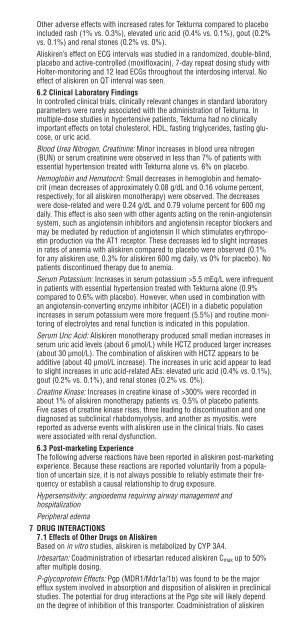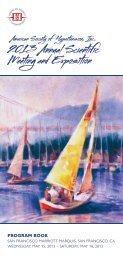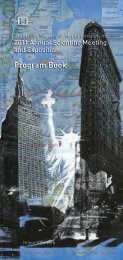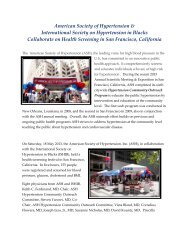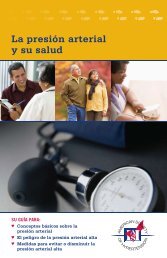Other adverse effects with increased rates for Tekturna compared to placeboincluded rash (1% vs. 0.3%), elevated uric acid (0.4% vs. 0.1%), gout (0.2%vs. 0.1%) <strong>and</strong> renal stones (0.2% vs. 0%).Aliskiren’s effect on ECG intervals was studied in a r<strong>and</strong>omized, double-blind,placebo <strong>and</strong> active-controlled (moxifloxacin), 7-day repeat dosing study withHolter-monitoring <strong>and</strong> 12 lead ECGs throughout the interdosing interval. Noeffect of aliskiren on QT interval was seen.6.2 Clinical Laboratory FindingsIn controlled clinical trials, clinically relevant changes in st<strong>and</strong>ard laboratoryparameters were rarely associated with the administration of Tekturna. Inmultiple-dose studies in hypertensive patients, Tekturna had no clinicallyimportant effects on total cholesterol, HDL, fasting triglycerides, fasting glucose,or uric acid.Blood Urea Nitrogen, Creatinine: Minor increases in blood urea nitrogen(BUN) or serum creatinine were observed in less than 7% of patients withessential hypertension treated with Tekturna alone vs. 6% on placebo.Hemoglobin <strong>and</strong> Hematocrit: Small decreases in hemoglobin <strong>and</strong> hematocrit(mean decreases of approximately 0.08 g/dL <strong>and</strong> 0.16 volume percent,respectively, for all aliskiren monotherapy) were observed. The decreaseswere dose-related <strong>and</strong> were 0.24 g/dL <strong>and</strong> 0.79 volume percent for 600 mgdaily. This effect is also seen with other agents acting on the renin-angiotensinsystem, such as angiotensin inhibitors <strong>and</strong> angiotensin receptor blockers <strong>and</strong>may be mediated by reduction of angiotensin II which stimulates erythropoetinproduction via the AT1 receptor. These decreases led to slight increasesin rates of anemia with aliskiren compared to placebo were observed (0.1%for any aliskiren use, 0.3% for aliskiren 600 mg daily, vs 0% for placebo). Nopatients discontinued therapy due to anemia.Serum Potassium: Increases in serum potassium >5.5 mEq/L were infrequentin patients with essential hypertension treated with Tekturna alone (0.9%compared to 0.6% with placebo). However, when used in combination withan angiotensin-converting enzyme inhibitor (ACEI) in a diabetic populationincreases in serum potassium were more frequent (5.5%) <strong>and</strong> routine monitoringof electrolytes <strong>and</strong> renal function is indicated in this population.Serum Uric Acid: Aliskiren monotherapy produced small median increases inserum uric acid levels (about 6 μmol/L) while HCTZ produced larger increases(about 30 μmol/L). The combination of aliskiren with HCTZ appears to beadditive (about 40 μmol/L increase). The increases in uric acid appear to leadto slight increases in uric acid-related AEs: elevated uric acid (0.4% vs. 0.1%),gout (0.2% vs. 0.1%), <strong>and</strong> renal stones (0.2% vs. 0%).Creatine Kinase: Increases in creatine kinase of >300% were recorded inabout 1% of aliskiren monotherapy patients vs. 0.5% of placebo patients.Five cases of creatine kinase rises, three leading to discontinuation <strong>and</strong> onediagnosed as subclinical rhabdomyolysis, <strong>and</strong> another as myositis, werereported as adverse events with aliskiren use in the clinical trials. No caseswere associated with renal dysfunction.6.3 Post-marketing ExperienceThe following adverse reactions have been reported in aliskiren post-marketingexperience. Because these reactions are reported voluntarily from a populationof uncertain size, it is not always possible to reliably estimate their frequencyor establish a causal relationship to drug exposure.Hypersensitivity: angioedema requiring airway management <strong>and</strong>hospitalizationPeripheral edema7 DRUG INTERACTIONS7.1 Effects of Other Drugs on AliskirenBased on in vitro studies, aliskiren is metabolized by CYP 3A4.Irbesartan: Coadministration of irbesartan reduced aliskiren C max up to 50%after multiple dosing.P-glycoprotein Effects: Pgp (MDR1/Mdr1a/1b) was found to be the majorefflux system involved in absorption <strong>and</strong> disposition of aliskiren in preclinicalstudies. The potential for drug interactions at the Pgp site will likely dependon the degree of inhibition of this transporter. Coadministration of aliskiren
with Pgp substrates or weak to moderate inhibitors such as atenolol, digoxin,<strong>and</strong> amlodipine did not result in clinically relevant interactions.Atorvastatin: Coadministration of atorvastatin, a weak Pgp inhibitor, resultedin about a 50% increase in aliskiren C max <strong>and</strong> AUC after multiple dosing.Ketoconazole: Coadministration of 200 mg twice-daily ketoconazole, a moderatePgp inhibitor, with aliskiren resulted in an approximate 80% increase inplasma levels of aliskiren. A 400-mg once-daily dose was not studied butwould be expected to increase aliskiren blood levels further.Cyclosporine: Coadministration of 200 mg <strong>and</strong> 600 mg cyclosporine, a potentPgp inhibitor, with 75 mg aliskiren resulted in an approximately 2.5-foldincrease in C max <strong>and</strong> 5-fold increase in AUC of aliskiren. Concomitant use ofaliskiren with cyclosporine is not recommended.Verapamil: Coadministration of 240 mg of verapamil, a moderate Pgp inhibitor,with 300 mg aliskiren resulted in an approximately 2-fold increase in C max <strong>and</strong>AUC of aliskiren. However, no dosage adjustment is necessary.Drugs with no clinically significant effects: Coadministration of lovastatin,atenolol, warfarin, furosemide, digoxin, celecoxib, hydrochlorothiazide,ramipril, valsartan, metformin <strong>and</strong> amlodipine did not result in clinically significantincreases in aliskiren exposure.7.2 Effects of Aliskiren on Other DrugsAliskiren does not inhibit the CYP450 isoenzymes (CYP1A2, 2C8, 2C9, 2C19,2D6, 2E1, <strong>and</strong> 3A) or induce CYP 3A4.Furosemide: When aliskiren was coadministered with furosemide, the AUC<strong>and</strong> C max of furosemide were reduced by about 30% <strong>and</strong> 50%, respectively.Patients receiving furosemide could find its effect diminished after startingaliskiren.Drugs with no clinically significant effects: Coadministration of aliskiren didnot significantly affect the pharmacokinetics of lovastatin, digoxin, valsartan,amlodipine, metformin, celecoxib, atenolol, atorvastatin, ramipril orhydrochlorothiazide.Warfarin: The effects of aliskiren on warfarin pharmacokinetics have not beenevaluated.8 USE IN SPECIFIC POPULATIONS8.1 PregnancyPregnancy Categories C (first trimester) <strong>and</strong> D (second <strong>and</strong> third trimesters)[See Warnings <strong>and</strong> Precautions (5.1)]There is no clinical experience with the use of Tekturna in pregnant women.Drugs that act directly on the renin-angiotensin system can cause fetal <strong>and</strong>neonatal morbidity <strong>and</strong> death when administered to pregnant women. Severaldozen cases have been reported in the world literature in patients who weretaking angiotensin-converting enzyme inhibitors. When pregnancy is detected,Tekturna should be discontinued as soon as possible. The use of drugs thatact directly on the renin-angiotensin system during the second <strong>and</strong> thirdtrimesters of pregnancy has been associated with fetal <strong>and</strong> neonatal injury,including hypotension, neonatal skull hypoplasia, anuria, reversible or irreversiblerenal failure, <strong>and</strong> death. Oligohydramnios has also been reported,presumably resulting from decreased fetal renal function; oligohydramnios inthis setting has been associated with fetal contractures, craniofacial deformation,<strong>and</strong> hypoplastic lung development. Prematurity, intrauterine growthretardation, <strong>and</strong> patent ductus arteriosus have also been reported, although itis not clear whether these occurrences were due to exposure to the drug.In addition, first trimester use of ACE inhibitors, a specific class of drugs actingon the renin-angiotensin system, has been associated with a potential riskof birth defects in retrospective data. Healthcare professionals that prescribedrugs acting directly on the renin-angiotensin system should counsel womenof childbearing potential about the potential risks of these agents during pregnancy.Rarely (probably less often than once in every thous<strong>and</strong> pregnancies),no alternative to a drug acting on the renin-angiotensin system will be found.In these rare cases, the mothers should be apprised of the potential hazardsto their fetuses <strong>and</strong> serial ultrasound examination should be performed toassess the intra-amniotic environment. If oligohydramnios is observed,Tekturna should be discontinued unless it is considered life-saving for themother. Contraction stress testing (CST), a nonstress test (NST) or biophysical
- Page 1 and 2: American Society of Hypertension201
- Page 3 and 4: Valturna offers bothsuperior BP eff
- Page 5 and 6: Figure 2: Probability of Achieving
- Page 7 and 8: potential for other drugs acting on
- Page 9 and 10: aliskiren arms were about one-third
- Page 11 and 12: As with other drugs that block angi
- Page 13: American Society of Hypertension201
- Page 18: Program Color KeyThe pages of this
- Page 21 and 22: General InformationThis program boo
- Page 23 and 24: General Information continuedHilton
- Page 25 and 26: General Information continuedASH Sc
- Page 27 and 28: General Information continuedASH Hy
- Page 29 and 30: 2010 ASH Corporate MembersBoehringe
- Page 31 and 32: ASH Leadership2009-2010 Board of Di
- Page 33 and 34: Special LectureMonday, May 3, 2010,
- Page 35 and 36: Special LectureMonday, May 3, 2010,
- Page 37 and 38: 2010 Abstract Reviewers continuedEr
- Page 39 and 40: Visit TEKTURNA at Booth 1100.and/or
- Page 41: 5.5 HyperkalemiaIncreases in serum
- Page 45 and 46: ASH Program at a GlanceSaturday, Ma
- Page 47 and 48: ASH Program at a GlanceMonday, May
- Page 49 and 50: Poster Category PresentationPosters
- Page 51 and 52: 2010 ASH Faculty continuedJeffrey R
- Page 53 and 54: 2010 ASH Faculty continuedAndrew Wh
- Page 55 and 56: 2010American Societyof Hypertension
- Page 57 and 58: Saturday Afternoon MAY 1PostersPost
- Page 59 and 60: Saturday Afternoon MAY 1Sessions3:3
- Page 61 and 62: Saturday Afternoon MAY 1Sessions3:3
- Page 63 and 64: Sunday Morning MAY 2Satellite Sympo
- Page 65 and 66: Sunday Morning MAY 2Sessions contin
- Page 67 and 68: Sunday Morning MAY 2Sessions8:00 AM
- Page 69 and 70: Sunday Morning MAY 2Sessions10:00 A
- Page 71 and 72: Sunday Morning MAY 2Sessions10:00 A
- Page 73 and 74: Sunday Afternoon MAY 2Sessions3:30
- Page 75 and 76: Sunday Afternoon MAY 2Sessions3:30
- Page 77 and 78: Sunday Afternoon MAY 2Special Sessi
- Page 79 and 80: Sunday Evening MAY 2Sessions6:00 PM
- Page 81 and 82: Sunday Evening MAY 2Sessions6:00 PM
- Page 83 and 84: Monday Morning MAY 3Satellite Sympo
- Page 85 and 86: Monday Morning MAY 3Sessions8:00 AM
- Page 87 and 88: Monday Morning Afternoon MAY 21 3Po
- Page 89 and 90: Monday Morning MAY 3Sessions10:00 A
- Page 91 and 92: Monday Morning MAY 3Sessions10:00 A
- Page 93 and 94:
Monday Morning MAY 3Sessions11:45 A
- Page 95 and 96:
Monday Evening May 3Satellite Sympo
- Page 97 and 98:
Tuesday Morning May 48:45 AM LB-OR-
- Page 99 and 100:
Tuesday Morning May 4Sessions8:00 A
- Page 101 and 102:
Tuesday Morning MAY 4ASH Membership
- Page 103 and 104:
Tuesday Morning MAY 4Sessions10:55
- Page 105 and 106:
2010American Societyof Hypertension
- Page 107 and 108:
Saturday Afternoon MAY 1Posters3:00
- Page 109 and 110:
Saturday Afternoon MAY 1PostersPO-2
- Page 111 and 112:
Saturday Afternoon MAY 1PostersPO-3
- Page 113 and 114:
Saturday Afternoon MAY 1PostersPO-4
- Page 115 and 116:
Saturday Afternoon MAY 1PostersPO-5
- Page 117 and 118:
Saturday Afternoon MAY 1PostersPO-7
- Page 119 and 120:
Saturday Afternoon MAY 1PostersPO-8
- Page 121 and 122:
Saturday Afternoon MAY 1PostersPO-9
- Page 123 and 124:
Saturday Afternoon MAY 1PostersPO-1
- Page 125 and 126:
Sunday Morning MAY 2PostersPosters
- Page 127 and 128:
Sunday Morning MAY 2Posters9:00 AM
- Page 129 and 130:
Sunday Morning MAY 2PostersPO-123:
- Page 131 and 132:
Sunday Morning MAY 2PostersPO-137:
- Page 133 and 134:
Sunday Morning MAY 2PostersPO-150:
- Page 135 and 136:
Sunday Morning MAY 2PostersPO-163:
- Page 137 and 138:
Sunday Morning MAY 2PostersPO-178:
- Page 139 and 140:
Sunday Morning MAY 2PostersPO-193:
- Page 141 and 142:
Sunday Morning MAY 2PostersPO-206:
- Page 143 and 144:
Monday Morning Afternoon MAY 21 3Po
- Page 145 and 146:
Monday Morning Afternoon MAY 21 3Po
- Page 147 and 148:
Monday Morning Afternoon MAY 21 3Po
- Page 149 and 150:
Monday Morning Afternoon MAY 21 3Po
- Page 151 and 152:
Monday Morning Afternoon MAY 21 3Po
- Page 153 and 154:
Monday Morning Afternoon MAY 21 3Po
- Page 155 and 156:
Monday Morning Afternoon MAY 21 3Po
- Page 157 and 158:
Monday Morning Afternoon MAY 21 3Po
- Page 159 and 160:
Monday Morning Afternoon MAY 21 3Po
- Page 161 and 162:
Monday Morning Afternoon May 213Pos
- Page 163 and 164:
Faculty Disclosure ListingGail Adle
- Page 165 and 166:
Faculty Disclosure Listing continue
- Page 167 and 168:
Faculty Disclosure Listing continue
- Page 169 and 170:
Faculty Disclosure Listing continue
- Page 171 and 172:
Faculty Disclosure Listing continue
- Page 173 and 174:
you to attend thethe Innovations Th
- Page 175 and 176:
5.5 HyperkalemiaIncreases in serum
- Page 177 and 178:
with Pgp substrates or weak to mode
- Page 179 and 180:
Valturna (aliskiren and valsartan,
- Page 181 and 182:
4 CONTRAINDICATIONSNone.5 WARNINGS
- Page 183 and 184:
een reported. In a 4-day trial of v
- Page 185 and 186:
7 DRUG INTERACTIONSNo drug interact
- Page 187 and 188:
8.5 Geriatric UseIn 8.5the Geriatri
- Page 189 and 190:
2010 ASH ExhibitorsASH Hypertension
- Page 191 and 192:
ASH Hypertension Resource CenterHil
- Page 193 and 194:
2010 ASH Exhibitors continuedCVRx I
- Page 195 and 196:
2010 ASH Exhibitors continuedIntern
- Page 197 and 198:
2010 ASH Exhibitors continuedNature
- Page 199 and 200:
2010 ASH Exhibitors continuedRESPeR
- Page 201 and 202:
Author IndexAAbaunza, Ricardo, 122A
- Page 203 and 204:
Author IndexCastellano, Maurizio, 1
- Page 205 and 206:
Author IndexGuarneri, Marco, 146Guo
- Page 207 and 208:
Author IndexLekakis, John, 118, 122
- Page 209 and 210:
Author IndexPittaras, Andreas, 149P
- Page 211 and 212:
Author IndexTello, Susana, 109, 135
- Page 213 and 214:
Hilton New York Floor PlansSecond F
- Page 215 and 216:
Hilton New York Floor PlansFourth F
- Page 218:
Are You 1in 3?Get the facts. Know y


